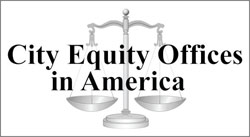
 |
City Equity Offices in America |
|
FRONT PAGE About us   ON OTHER PAGES Corrupt US mayors US Supreme Court versus City Halls American cities of violence 2020 US Census - Counting Americans US mayors caught up in nation's culture war New York's Borough presidents Opinion: Trust and race in America Opinion: Fighting racism in America Hunger in America Post-Covid, American cities strengthen economic equity, resilience and regionalism An American Dream for the 21st century City Equity Offices to counter systematic racism in America List of US City Equity Offices The guns of America American mayors: Moral values in politics Opinion: Fighting racism in America African American Mayors Ending racism in American cities - a conversation with Rochester's (NY) first black mayor Police killings of Black Americans COVID-19 hits African Americans hardest US local government structures US mayors (2020) World's capital cities and their mayors (2020) |
 City Equity Offices to counter City Equity Offices to countersystematic racism in America September 2020: In August 2014, a white police officer in Ferguson, Missouri shot and killed Michael Brown, an unarmed 18-year-old Black man. The killing precipitated protests in Ferguson and soul searching throughout America over racial discrimination. Within a few years of the death of Michael Brown, at least 32 cities in the United States established or strengthened a municipal equity office, including Austin, Louisville, Boston, and Oakland. These offices represented the first efforts ever undertaken by American cities to focus explicitly on systemic racism. The offices examine city governments’ internal processes and/or delivery of public services with a goal of eliminating institutional inequities and the discrimination born of it. Inequities are defined as “disparities in health, mental health, economic, education, or social factors that are systemic and avoidable and, therefore, considered unjust or unfair,” according to the Albuquerque, New Mexico Office of Equity & Inclusion. Few new city equity offices were created since the furor over Ferguson subsided. Now, in response to the recent police killing of George Floyd and the resulting civic unrest, there is a renewed effort to eliminate the unequal opportunities and unequal outcomes that come from systemic discrimination. Many local governments of all sizes in the United States have gotten the message that race matters. They are seeking to proactively identify and eliminate inequities—and advance equity—in policy and program development, budgeting, and decision-making. A review of the mission, activities, and other characteristics of existing municipal equity offices may offer insights to forthcoming efforts by American cities to eliminate systemic discrimination and racism. Characteristics of City Equity Offices The mission or purpose statements of the 32 existing municipal equity offices analyzed for this article show considerable variation. Some offices focus on race only; most focus on race and social justice more broadly. For example, the City of Portland’s Office of Equity and Human Rights focuses on race and disability only. Seattle’s Office for Civil Rights addresses race, gender, disability, sexual orientation, and housing discrimination. Most of the equity offices focus exclusively on eliminating inequities within their municipal workforces. They may focus on city administrative practices, such as hiring and procurement, and/or on city departments to address variances in the impacts of the municipal services on different racial and demographic groups in their cities. The mission of other equity offices encompasses the community at large, especially the city’s role as a direct service provider and community partner. The Atlanta Mayor’s Office of Equity, Diversity and Inclusion has one of the broadest missions, calling for city government to work with the private and nonprofit sectors to dismantle systemic inequities. Tools employed by city equity offices include assessments of inequities, staff training, capacity building initiatives, specific programs to address inequities, monitoring of progress, and evaluation of results. The most common activities performed by local government equity offices include: • Receiving and investigating discrimination and harassment complaints to ensure Equal Opportunity Employment practices are in place. In order to receive federal funds, local governments in the US must ensure their hiring and contracting practices comply with federal nondiscrimination laws and provide equality of employment opportunity. More than half of the cities studied perform these functions through a consolidated EEO/equity office. • Training staff on racial issues and bias, as well as other forms of inequity affecting various groups. • Advancing equity in government procurement policies and practices to ensure fairness and diversity in contracting. • Collecting data on equity and disparity in their cities. It is not clear that many of the activities reported by city equity offices have been adequately sustained over the past five or so years since the offices were established or given a sharper focus on eliminating systemic discrimination. On several city websites, tools such as equity impact assessments and equity action plans appear outdated, giving a sense that equity is not fully incorporated into city operations. On the other hand, most city equity offices appear to have invested time and money into providing staff, policymakers, and community members with opportunities to take part in trainings, workshops, discussions, and planning around equity. Such activities can contribute to building a shared understanding and a shared language among different groups in a municipality. A few equity offices explicitly report that their cities link budget allocation decisions to addressing social equity issues. Baltimore is nationally-recognized for incorporating equity into its budget process by conducting annual outcome assessments in key priority areas and using the results to inform the city’s budget process. The City of Pittsburgh has created baseline measures of inequality in such areas as health, education, housing, safety, and civic engagement. The baseline “equality scores” are evaluated annually to help determine how resources should be allocated. Most of the equity offices report directly to the mayor or city manager, signaling that these offices receive support from upper leadership and have a prominent position and visibility within city government. The appearance of legitimacy can also be a concern. For example, the City of Madison’s Equity Coordinator originally reported to the mayor, but city council reassigned the position for “greater neutrality” and to convey an apolitical will to solve equity-related problems. Most city equity offices utilize models developed by national organizations to facilitate the development and analysis of policies, practices, plans, and decisions. National organizations can provide technical support, training, tools, best practices, and other resources. Most cities partnered with the Government Alliance on Race and Equity, or a partnership between GARE and another national equity-focused organization. GARE is a national network of governments in the US working together to achieve racial equity. The GARE model supports local governments with implementing six strategies: (1) use a racial equity framework; (2) build organizational capacity; (3) implement racial equity tools; (4) be data-driven; (5) partner with other institutions and governments; (6) operate with accountability and urgency. In addition to working with national organizations, many cities report close collaborations with local community leaders to move equity discussions forward. In Louisville, for example, community groups play a key role in data collection. Such data become the basis of performance management systems that are then used by the city to allocate resources equitably Conclusion It is important to note that, while this article examines only established city equity offices, many other cities in the United States without formal offices have a number of initiatives and programs underway to address racial and other socioeconomic inequalities. In June 2020, Mayor Eric Garcetti of Los Angeles signed an executive directive which, in his words, will ensure his city “looks at every issue through a lens of racial justice and acts to end structural racism.” In announcing the directive, Mayor Garcetti captured the current mood in many American cities: “Our city is hungry for change,” he said, “and we must knit racial justice and affirmative action into the fabric of our policies, our institutions, and our society.” The advantage of an equity office is in providing leadership, direction, coordination, support, and visibility for a city’s equity-related efforts. Successful equity offices can offer a model for desired systemic change. Methodology This article identifies equity offices in 32 American cities [1]. The offices were identified through their participation in national equity-focused organizations, such as the Government Alliance on Race and Equity, Racial Equity Here, and 100 Resilient Cities. These organizations have developed models and toolkits to assist participating cities in implementing changes in their policies and procedures to address systemic biases against certain racial groups. Many of these national efforts were launched in 2015 in response to the events in Ferguson. They are not the only national organizations currently providing technical assistance related to equity to municipalities. City equity offices were also identified for this article through a web search using such terms as “equity”, “racial equity”, “inclusion”, “human rights”, “civil rights”, “city”, and “local government”. The research, therefore, was limited, and there are likely more American cities with equity offices than are referenced in this article. Moreover, at least seven American counties have official equity offices, which are not considered in this article. The Equity Offices of the following cities were analyzed for this article: Albuquerque, Asheville, Atlanta, Austin, Baltimore, Boston, Cambridge, Cedar Rapids, Champaign, Cleveland, Denver, Eugene, Evanston, Grand Rapids, Harrisburg, Iowa, Long Beach, Louisville, Madison, Minneapolis, New Orleans, New York City, Oakland, Philadelphia, Pittsburgh. Portland, Sacramento, San Antonio, Seattle, St Louis, Tacoma, Tulsa. Full list of America’s 32 City Equity Offices, their missions, scope of work, and partnerships with national organizations Sources used: [1] This article borrows from, and builds on, a 2019 survey of local government equity offices prepared for the City and County of San Francisco Board of Supervisors: Policy Analysis Report. Survey of Other Local Offices of Equity and Current Efforts of the City and County of San Francisco to Address Racial and Other Inequities. San Francisco Budget and Legislative Analyst’s Office, May 1, 2019. © Copyright: City Mayors Foundation. All rights reserved d Follow @City_Mayors |